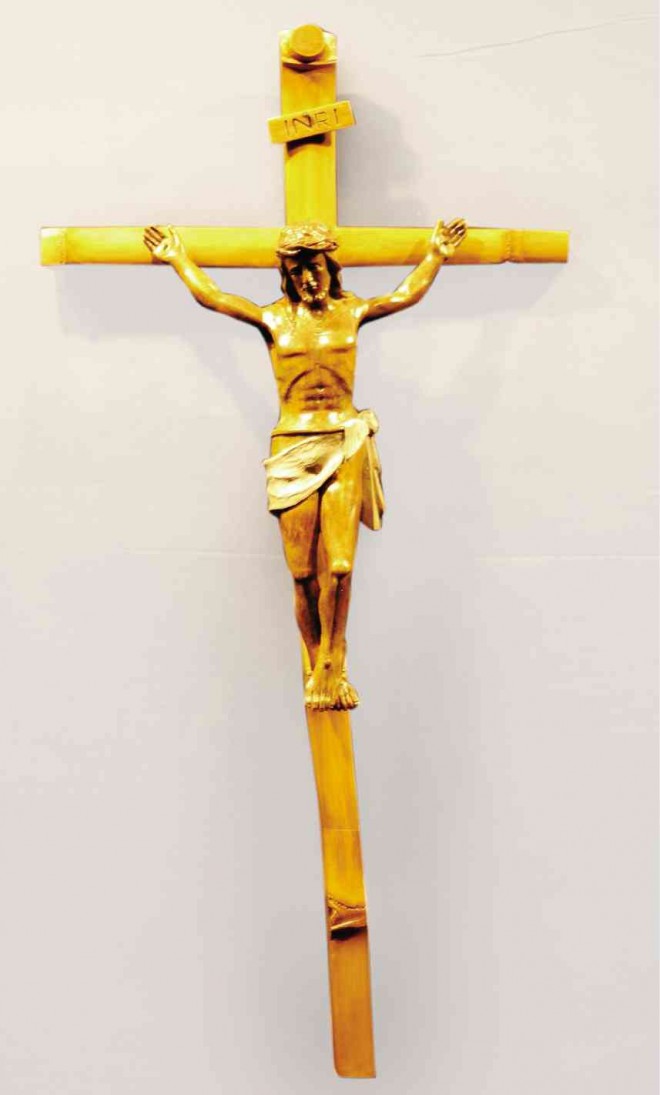Piety takes another form in bamboo

ART EXPRESSING Filipino piety, using bamboo instead of wood, were put on display for the Lenten week in Baguio City by traditional woodcarvers of Paete, Laguna. The works include this crucifix made from bamboo. EV ESPIRITU/INQUIRER NORTHERN LUZON
BAGUIO CITY, Philippines—Filipino piety is on display at this city’s new home for bamboo art, courtesy of craftsmen from Paete town in Laguna province.
The Paete carvers joined their counterparts in Ifugao province for a Lenten exhibit at the “White House” here, which aims to popularize bamboo, particularly the “kawayang tinik” (Bambusa blumeana), as an alternative medium for woodcarvers.
The White House, a colonial American home on Leonard Wood Road, has inspired ghost stories because of its haunting look until its owners allowed it to be used as a museum for Ifugao carvers who have been experimenting with bamboo.
The Paete carvers are known for their Spanish-influenced religious art and their exhibit features bamboo pieces engraved with Biblical icons like Jesus Christ.
Their pieces were set side-by-side with intricate bamboo sculptures by Ifugao carvers.
Article continues after this advertisementRoldan Paet, 33, head of the Asin Bamboo Carvers’ Guild, finds working on bamboo harder than wood as it takes twice the time to carve out shapes on bamboo.
Article continues after this advertisementUnlike trees, however, bamboo is far easier to grow, he said.
“We chose bamboo because we have lost our forests…. We need to wait only a for a year and a half for bamboo to be mature enough to carve. A tree needs 25 years to mature. It would be painful to cut a tree that has taken that long to grow,” he said.
Dhan Cads, 50, a member of the Paete Artist Guild, said bamboo carving needs some time to master.
“I needed to study. You can’t create anything beautiful unless you study how. I’ve managed to improve the beard of [one of my pieces, the face of Moses],” said Cads.
Having started as a wood polisher for a woodcarving shop in Paete, Cads said he is obsessed about carving faces perfectly. “The face is what customers seek out first,” he said.
There is also some form of ritual involved in creating religious art, which Paete’s sculptors want to maintain when using bamboo.
For example, carving the face of Jesus Christ must be done at a certain hour.
“The woodcarvers have pledged to the ‘Mahal na Señor’ (Jesus Christ) that carving his face may only be performed at 3 p.m. every Friday. Folk wisdom tells us we risk bad luck and poverty if we fail to heed that promise,” said Phaern Afurong, 60, the Paete guild founder.
His works feature bamboo images of the Santo Niño (the Child Jesus) and Padre Pio, the saint revered for suffering the stigmata, or the wounds that Christ endured during crucifixion.
Afurong said the Santo Niño images are in demand during Lent, while Padre Pio’s image is often requested by migrant workers.
His works also feature bamboo with the face of the Virgin Mary, as well as a bamboo crucifix.
Cads put on display a piece called “Creation,” which shows a giant hand reaching out to representations of Adam and Eve.
His other work, “Ten Commandments,” features Moses, complete with the tablets on which God etched the Biblical 10 commandments.
Normandy Kahatol, another Paete carver, put on display his first bamboo creation, called “Bird Lovers.” He is known for carving the Sto. Niño statue which the Immaculate Conception Church in Pasig City has been using for processions.
“I stopped carving for 30 years, but I returned to the art when bamboo was introduced to us,” he said.
Paet said bamboo sculpting has been drawing a new market, primarily because it has been categorized as environment-friendly. He said bamboo used to be considered as the poor man’s timber.
The campaign to popularize bamboo in woodcarving has been championed for years by the Philippine Bamboo Foundation Inc. The group has partnered with the Diocese of Baguio to showcase a demonstration nursery at St. Francis Seminary to encourage people to plant more bamboo.